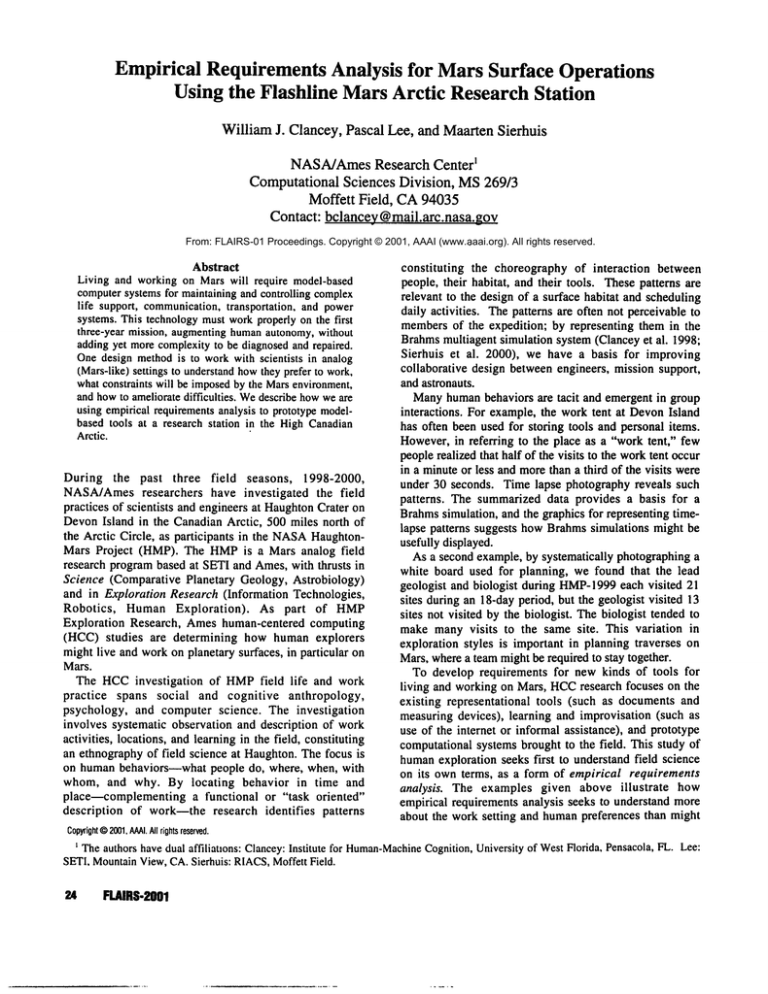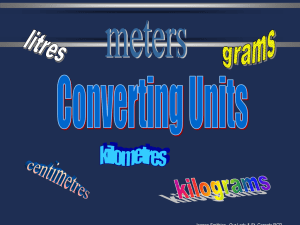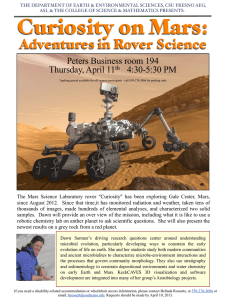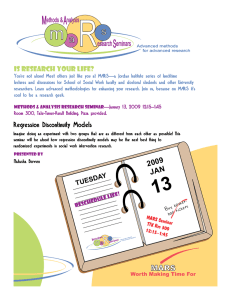
Empirical RequirementsAnalysis for Mars Surface Operations
Using the Flashline MarsArctic ResearchStation
William J. Clancey, Pascal Lee, and Maarten Sierhuis
]NASA/Ames Research
Center
Computational Sciences Division,
MS 269/3
Moffett Field, CA 94035
Contact: bclancey @ mail.arc.nasa,
gov
From: FLAIRS-01 Proceedings. Copyright © 2001, AAAI (www.aaai.org). All rights reserved.
Abstract
Living and working on Mars will require model-based
computersystemsfor maintainingand controlling complex
life support, communication,transportation, and power
systems. This technologymustworkproperly on the first
three-year mission, augmentinghumanautonomy,without
addingyet morecomplexityto be diagnosedand repaired.
Onedesign methodis to workwith scientists in analog
(Mars-like)settings to understandhowthey prefer to work,
whatconstraints will be imposedby the Marsenvironment,
and howto amelioratedifficulties. Wedescribe howweare
using empiricalrequirementsanalysis to prototypemodelbased tools at a research station in the HighCanadian
Arctic.
constituting the choreography of interaction between
people, their habitat, and their tools. Thesepatterns are
relevant to the design of a surface habitat and scheduling
daily activities. The patterns are often not perceivable to
membersof the expedition; by representing them in the
Brahmsmultiagent simulation system (Clancey et al. 1998;
Sierhuis et al. 2000), we have a basis for improving
collaborative design between engineers, mission support,
and astronauts.
Manyhumanbehaviors are tacit and emergent in group
interactions. For example, the work tent at DevonIsland
has often been used for storing tools and personal items.
However,in referring to the place as a "work tent," few
people realized that half of the visits to the worktent occur
in a minuteor less and morethan a third of the visits were
under 30 seconds. Time lapse photography reveals such
patterns. The summarized data provides a basis for a
Brahmssimulation, and the graphics for representing timelapse patterns suggests howBrahmssimulations might be
usefully displayed.
As a second example, by systematically photographing a
white board used for planning, we found that the lead
geologist and biologist during HMP-1999
each visited 21
sites during an 18-dayperiod, but the geologist visited 13
sites not visited by the biologist. The biologist tended to
make many visits to the same site. This variation in
exploration styles is important in planning traverses on
Mars, wherea team might be required to stay together.
To develop requirements for new kinds of tools for
living and working on Mars, HCCresearch focuses on the
existing representational tools (such as documents and
measuring devices), learning and improvisation (such
use of the internet or informal assistance), and prototype
computational systems brought to the field. This study of
humanexploration seeks first to understand field science
on its own terms, as a form of empirical requirements
analysis. The examples given above illustrate
how
empirical requirements analysis seeks to understand more
about the work setting and humanpreferences than might
During the past three field seasons, 1998-2000,
NASA/Amesresearchers have investigated the field
practices of scientists and engineers at HaughtonCrater on
DevonIsland in the Canadian Arctic, 500 miles north of
the Arctic Circle, as participants in the NASA
HaughtonMars Project (HMP). The HMPis a Mars analog field
research program based at SETIand Ames,with thrusts in
Science (Comparative Planetary Geology, Astrobiology)
and in Exploration Research (Information Technologies,
Robotics,
Human Exploration).
As part of HMP
Exploration Research, Ames human-centered computing
(HCC) studies are determining how human explorers
might live and workon planetary surfaces, in particular on
Mars.
The HCCinvestigation
of HMPfield life and work
practice spans social and cognitive anthropology,
psychology, and computer science. The investigation
involves systematic observation and description of work
activities, locations, and learning in the field, constituting
an ethnographyof field science at Haughton.The focus is
on humanbehaviors--what people do, where, when, with
whom, and why. By locating behavior in time and
place--complementing a functional or "task oriented"
description of work--the research identifies patterns
Copyright
©2001.
AAAI.
Allrights
reserved.
t Theauthors havedual affiliations: Clancey:Institute for Human-Machine
Cognition,Universityof WestFlorida, Pensacola,FL. Lee:
SETI,MountainView,CA.Sierhuis: RIACS,Moffett Field.
24
FLAIRS-2001
have immediate application to computer system design.
Indeed, having such a broad understanding becomes a
heuristic for ensuring that introduced technology does not
have unintended consequences.
Application of model-based systems at DevonIsland is
focusing on requirements for habitat systems, computing
infrastructure and data collection tools, and collaboration
methodsfor mission operations support. The areas of most
interest include:
¯
¯
¯
¯
Communication
protocols (mission support in
Houston,collaborating PIs on Earth, the public)
Telecommunication/computer equipment (hab,
rover, spacesuit, earth)
Automation(life support, rovers, science, and
exploration)
Telescience, telemedicine, training
Two key problems were highlighted in the HMP-2000
expedition during a trial occupation of the FMARS.
First,
it will not be practical on Marsto repeatedly revisit sites
merelyfor checking that scientific instruments are working
and to download data. On Mars we will prefer to use
telemetry for accessing remote instruments; data will be
sent directly to the habitat and then back to Earth. One
approachis to transmit data directly from a field-deployed
instrumentto a satellite, and then to an internet available
both on the Mars surface and on an Earth. For example, the
weather station already deployed at DevonIsland could be
connected to the FMARS
and mission support in this way.
Withthis infrastructure, it becomespossible to experiment
with distributed human-machinelearning, taking into
account that both the crew and mission support will be
learning about Mars phenomena,such as the weather, and
that adaptive programs will be used to process data and
monitor or control equipment.
A second problemis that we do not believe that it will
be practical for several crew membersto spend several
hours a day composing and formatting reports to be
"downloaded"to mission support. Weneed to find ways to
automate the reporting process, such as by automated
transcription of audio logs or by automated recording of
crew movements.
One approach for augmenting humancapabilities is to
examine how computer tools have been adopted on a
volunteer basis. The different ways in which computersare
used in a modernfield expedition were highlighted by a
written survey completed by the participants in the month
following the HMP-1999
field season. Important findings
are summarizedin Table 1. The greatest surprise is how
many people downloaded and/or learned to use new
software. Very likely new tools will become available
during a three-year Mars mission. This highlights that
training will be an ongoing activity, complicated by the
time delay that will prevent conversations with instructors
on Earth.
Aside from laptop computers, the most prevalent use of
computing is the digital camera. The average number of
digital photographs was 137, yet only two people used a
photo database (on average 204 conventional photographs
were taken per person). This information and related
observations has suggested that we develop tools that
combine databases, maps, GPS readings and digital
cameras. Observations about internet usage are useful for
determining whether a Mars crew should be allowed to
interact directly with colleagues on the internet, or whether
mission support should enforce the present-day protocol of
having a mission support officer filter and reformat
communications.
Table 1. Computerand digital device usage during
HMP-99expedition (N = 25)
Computer Usage
Used a computer
Browsed web
Downloadedsoftware
Percentage
92%
68%
32%
Learnedto use newsoftware
52%
Sent e-mail
Usede-mail daily
88%
60%
Sent digital photographs
Informedcolleagues or sought
advice
Watched a full DVDmovie
Useda digital camera
52%
64%
Used computeroutside or
in personaltent
76%
64%
16%
Together the time lapse analysis and surveys have
highlighted the importance of systematic observations, by
which events are counted. Patterns in use of space and
tools are not obvious to membersof the group, and are
even missed by trained observers. Representing these
patterns in the Brahmsmultiple-agent simulation system is
becoming a key method for summarizing data and
applyingit to alternative worksystemdesigns.
In summary, HCC investigations
during HMP
expeditions have suggested several hypotheses that are
shaping NASA’soperations planning and technology
design for surface operations on Mars:
¯
Exploration is not just about covering the most area in
the most time; continuously revisiting places is
essential.
¯
Living on Mars might change scientific practice,
physically constraining howthe work is done and how
analysis and publication are coordinated.
AI IN AEROSPACE26
¯
Animportant use of computerswill be for life support
automation and mediating communicationwith Earth,
not just for assisting scientists in direct field
exploration.
¯
Protocols for Mars-Earth communications should be
designed to help Mission Control learn about human
activities on Mars and adjust its support role as
surface practices develop.
These developing perspectives illustrate the value of an
empirical requirements analysis process, by which
computer scientists live and work with experts in an
authentic, evocative setting. By characterizing behavior
patterns (in use of facilities and tools, as well as teaming
and scheduling), a baseline of preferred behaviors is
established. Constraints on such behaviors on Mars can
then be articulated, and protocols or tools developedthat
ameliorate difficulties. Prototypes are then brought to the
work setting and experimentally used in controlled
protocols. The quality of the work is examined and the
process iterates. In this way, an analog setting provides a
way of both articulating requirements, and trying out
equipment, procedures, and training for an actual mission
to Mars.
Acknowledgments
Dozens of researchers at NASAcenters and universities
have contributed to the HMP. The authors wish to
acknowledge their colleagues who have contributed
directly to the work reported here: Rick Alena, Steve
Braham, Geoff Briggs, TomDiegelman, Brian Glass, Tony
Griffith, Steve Hoffman,John O’Neill, and RoxanaWales.
References
Clancey, W.J., Sachs, P., Sierhuis, M., and van Hoof, R.
1998. Brahms: Simulating Practice for Work Systems
Design. International
Journal of Human-Computer
Studies, 49, 831-865.
Haughton-Mars
Project. 2001. http://www.arcfic-mars.org.
Sierhuis, M., Clancey, W.J., van Hoof, R., and de Hoog,
R. 2000. Modeling and Simulating Human Activity.
AutonomousAgents 2000 Workshop on Intelligent Agents
for Computer Supported co-operative Work: Technology
and Risks, Barcelona. Spain.
26
FLAIRS-2O01





